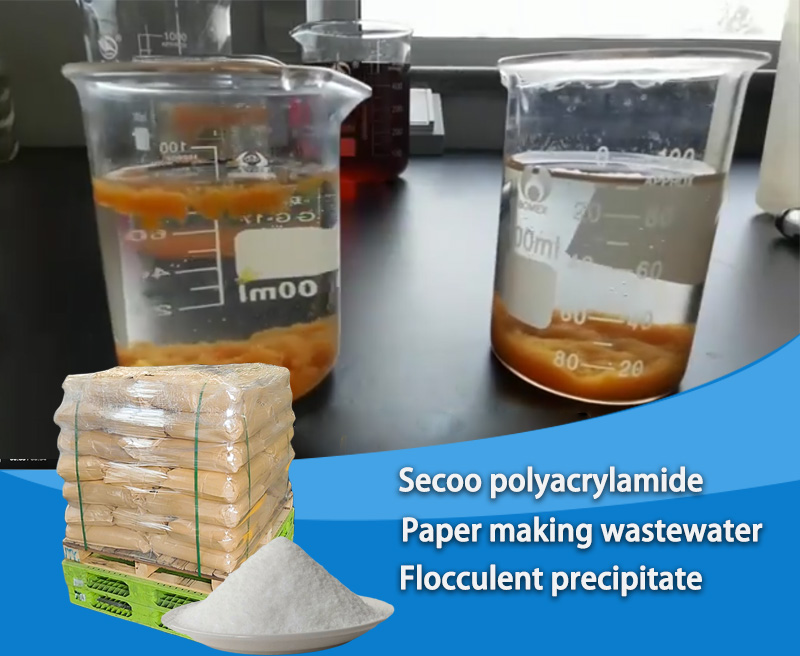Polyacrylamide (PAM) is a critical chemical agent in treating paper mill wastewater. Its proper selection and application are paramount for efficient operations, compliance with environmental regulations, and cost control.

polyacrylamide
1. The Role of PAM in Paper Mill Wastewater Treatment
PAM is a water-soluble polymer that primarily functions through two mechanisms:
Coagulation (Charge Neutralization): Primarily for cationic PAM. Its positive charges neutralize the negative surface charges (Zeta potential) of colloidal particles (e.g., fibers, fillers, dyes), destabilizing them and allowing them to aggregate.
Flocculation (Bridging): The long polymer chains of PAM adsorb onto the surfaces of destabilized particles and bridge them together, forming large, dense, and fast-settling flocs.
The overall effects are:
Enhanced Solid-Liquid Separation: Rapid formation of settleable or floatable flocs in clarification processes (sedimentation or flotation).
Improved Water Quality: Significant reduction in Suspended Solids (SS), Chemical Oxygen Demand (COD), color, and turbidity of the treated water.
Superior Sludge Dewatering: Condition sludge by binding fine particles, releasing bound water, and increasing the solid content of the dewatered cake, reducing disposal volume and cost.
2. Selection of Polyacrylamide (PAM)
Selection is a complex process that must be determined by laboratory jar tests and on-site trials, as wastewater composition varies greatly between mills. PAM is categorized by its ionic charge:
A. Selection by Ionic Type and Application Stage
Process Stage Wastewater/Sludge Characteristics Recommended PAM Type Rationale
Primary Treatment (Clarification: Sedimentation/Flotation) Neutral/alkaline pH, high load of negatively charged fibers, fillers (kaolin, CaCO₃), and colloids. High SS and COD. Anionic (APAM) or Non-Ionic (NPAM) Anionic PAM works synergistically with inorganic coagulants (e.g., PAC, alum). The coagulant neutralizes charges; APAM then bridges the destabilized particles into large flocs. NPAM is effective in neutral pH ranges.
Sludge Dewatering (Belt Press, Centrifuge) Sludge from biological treatment or primary clarification. High organic content, strongly negative charge, hydrophilic, and difficult to dewater. Cationic (CPAM) The positive charges of CPAM effectively neutralize the negative charges of organic sludge particles. This, combined with polymer bridging, destroys the stable colloid structure, releasing water and improving dewaterability.
Dissolved Air Flotation (DAF) Contains light materials like fines, resins, and sizing agents. Anionic (APAM) or Low Ionicity Cationic Forms strong, stable flocs of the right size and density for effective attachment to micro-air bubbles and rapid flotation.
B. Selection by Molecular Weight (MW)
Very High MW (>18 million g/mol): Ideal for clarification. Long polymer chains provide excellent bridging, forming large, fast-settling flocs.
Medium to High MW (10 – 18 million g/mol): The most common range for sludge dewatering. Balances bridging ability with solution viscosity and handling.
C. Selection by Ionicity (For Cationic PAM – Critical for Dewatering)
Ionicity (charge density) is expressed as a percentage and is the key parameter for choosing a cationic PAM for sludge dewatering.
Low Ionicity (10-30%): Best for inorganic sludges (e.g., from primary treatment with lime or clay). These sludges require more bridging than charge neutralization.
Medium Ionicity (40-60%): The most versatile range. Suitable for mixed sludges (a blend of primary and biological sludge).
High Ionicity (>60%): Essential for organic, biological sludges. These sludges have a high negative charge density and require strong charge neutralization to break down stable, water-holding colloids.
Note: Higher ionicity is not always better. Excess charge can cause polymer chain coiling, reducing its bridging efficiency and increasing cost.
3. Evaluating and Optimizing Effectiveness
After a preliminary selection, performance must be tested and optimized.
Jar Testing:
Determine Optimal Dosage: Test different doses of PAM under controlled stirring conditions. Observe floc formation size, settling speed, and clarity of supernatant. Find the dose that gives the best performance at the lowest cost.
Optimize Mixing: Rapid mix (for initial dispersion) and slow mix (for floc growth without shearing) are both critical.
Pilot/Field Trials:
Conduct trials on the actual equipment (e.g., belt press). Monitor key performance indicators: cake dryness, polymer consumption rate, clarity of centrate/filtrate, and processing throughput.
Key Performance Indicators (KPIs):
Clarification: Settling velocity, supernatant turbidity/SS, COD removal.
Dewatering: Cake Solids Content (%), capture rate, filtrate clarity, and dosage per ton of dry solids.
4. Important Usage Considerations
Dissolution: Must be prepared with clean water at room temperature (< 60°C). Use an automated mixing and aging system to ensure complete dissolution (typically 40-60 minutes) at a concentration of 0.1%-0.3%. Incomplete dissolution creates “fish eyes,” reduces efficacy, and can clog equipment.
Storage: Dry powder must be stored in a cool, dry place in sealed containers to prevent moisture absorption and caking. Prepared solution has a limited shelf life (usually <24 hours) as the polymer chains degrade, reducing viscosity and effectiveness.
Point of Addition: The injection point must ensure optimal contact and mixing with the sludge or wastewater.
pH: Wastewater pH can affect the charge density and performance of PAM. pH adjustment may be necessary before polymer addition.
Summary
There is no universal PAM for paper mill wastewater.
Golden Rule: Clarification typically uses Anionic PAM; Sludge Dewatering primarily uses Cationic PAM.
Key Method: Selection must be based on jar testing and field trials to find the optimal ionic type, molecular weight, and ionicity for the specific wastewater and sludge stream.
Ultimate Goal: To achieve the best treatment efficiency (clear water, dry cake) at the lowest operating cost.
Collaborating with knowledgeable PAM suppliers who can provide technical support and sample testing is highly recommended for optimal results.